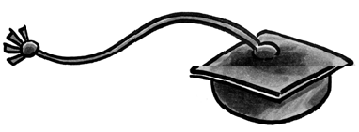
ABSTRACT OF DISSERTATION

Investigations about the chemical ecology of the cabbage webworm, Hellula undalis (Fabricius) (Lepidoptera: Pyralidae)
The cabbage webworm, Hellula undalis (Fabricius) (Fig. 1 and 2), is a pest in crucifers in the tropics and subtropics. Although this pyralide moth is also found in temperate climates, here infestations are transient, because the development of H. undalis is delayed or interrupt at temperatures below 20 ºC. This is a serious pest because of the behavior of larvae. After initial mining on leaves, young larvae migrate to the growing point of plants. Here, while enclosed in a loose web, larvae feed on the sensitive plant meristemes and cause major damage especially to young plants. Feeding damage by a single larva results in termination of development, and plant mortality, or the formation of multiple shoots.
|
|
|
|
Fig. 1: Oviposition of H. undalis adult. |
Abb. 2: H. undalis 5th instar. |
Since 1993 H. undalis is considered as one of the most serious pests of crucifers in the Philippines, along with Plutella xylostella and Spodoptera litura. Chemical control of H. undalis is not effective against early instars because larvae are shielded in a loose web in the growing point. Alternative biological control techniques and basic research are needed, therefore, to develop IPM-strategies. Little is known about the chemical ecology and biology of H. undalis; however, such basic information’s are needed for the development of useful IPM strategies and therefore object of this study.
|
Hellula undalis (Fabricius) was a year around pest in insecticide treated and untreated cabbage fields in the Philippines in 1998–2001 (Fig. 3). |
Fig. 3: Thousands of larvae can be observed in a destroyed cabbage field. |
In the Philippines H. undalis is passing five larval stages, a prepupal and a pupal stage (Fig. 4, 5 and 6). The sex of adults can be easy distinguished by abomen (Fig. 7). Furthermore, sex of pupae can be determined by the last two abdomen segments (Fig. 8).
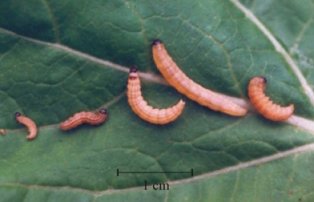 |
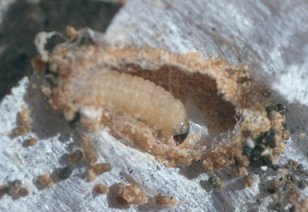 |
|
Fig. 4: 2nd-5th instar and prepupae (f. l. t. r.). |
Fig. 5: Prepupa in cocoon. |
 |
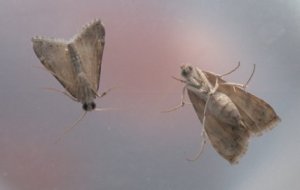 |
| Abb. 6: Pupa in cocoon. | Fig. 7: Sex dimorphism of adults. |
|
|
|
| Abb. 8: Sex dimorphism of pupae. | |
Bioassays about the migration behavior of H. undalis on Brassica campestris L. ssp. chinensis var. Black Behi (pak-choi) showed that 1st instar larvae start mining in the leaves. First migration to the growing point was observed on the second day. Significant more larvae fed on the growing point then on leaves and petioles from the second day until pupation, if one larva was feeding on a single plant (Fig. 9). If five larvae fed on a single pak-choi plant, significant more larvae were observed on the growing point on day four, however, later on they spread over the plant and only one (rarely two) larvae remained in the growing point. According to the chemical analysis of plant part the growing point showed the highest total glucosinolate content, following by leaves and petioles. The smallest number of larvae was observed on petioles.
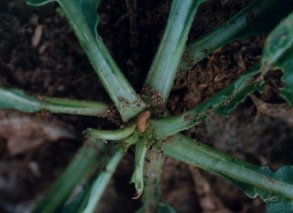 |
| Fig. 9: Typical feeding damage by 5th instar larvae. |
That glucosinolates influence the migartion of H. undalis larvae was demonstrated by using sinigrin. Larvae fed significant longer on pak choi leaves compared to control plants when leaves have been previously treated with 10‑4 M sinigrin and only few larvae migrated to the growing point. Furthermore, sinigrin (10‑4 M) has been shown to stimulate feeding of 3rd instar larvae on the non-host plant Vigna sesquipedalis.
H. undalis adults differentiated among host-plant species for oviposition in laboratory and field tests. White mustard, Sinapis alba (L.) var. Selinda, was the preferred host-plant, followed by Brassica juncea (L.) Czern. et. Coss var. Canadian brown mustard, and pak-choi, Brassica campestris L. ssp. chinensis var. Joi Choi, Black Behi and Bai Tsai. Secondary plant compounds, known as glucosinolates, and their breakdown products, present in the three plant species, were analyzed by using HPLC and GC-MS-techniques. Species differed in glucosinolates composition and concentration. Content of GS was highest in S. alba with progressively lower contents detected in B. juncea and B. chinensis. The aromatic glucosinolates, sinalbin and glucotropaeolin, were detected in S. alba. In B. juncea the alkenyl glucosinolates, sinigrin (also detected glucobrassicin and gluconasturtiin), dominated, whereas in varieties of B. chinensis indolyl (glucobrassicin, 4-methoxyglucobrassicin, neoglucobrassicin) and alkenyl GS (progoitrin, gluconapin, glucobrassicanapin und gluconasturtiin) predominated. At least on corresponding hydrolysis product for each glucosinolate was detected. The formed hydrolysis product of glucosinolates was depending on the chain residue on aglucones. Aromatic glucosinolates usually formed isothiocyanates and cyanides, whereby isothiocyanates were mostly detected as hydrolysis products of alkenyl glucosinolates. As corresponding form of indolyl glucosinolate cyanides were detected.
Upon plant damage the total glucosinolatate content of B. chinensis increased significantly compared to intact plants. It was due to an increase in indolyl glucosinolate content, whereby particularly glucobrassicin increased.
Leaf washes of B. chinensis and S. alba with dichloromethane and following methanol, different glucosinolates were detected in the methanol extract. However, no hydrolysis products of glucosinolates were detected in the dichloromethane extract.
H. undalis females prefer intact plants for oviposition. Egg laying on B. chinensis was significantly reduced upon plant damage and after application of cabbage juice. The hydrolysis product of glucobrassicin, 3-indolylmethylcyanid and the breakdown product from progoitrin, 5-vinyl-oxozolidine-2-thione, were identified as repellent compounds for oviposition.
It has been demonstrated that glucosinolates stimulate oviposition in H. undalis females. Significant more eggs were laid on dummies as well as on the non-host-plant V. sesquipedalis if they have been treated with 10–4 M sinigrin. Furthermore, H. undalis was able to distinguish between glucosinolates. Females laid significant more eggs on V. sesquipedalis leaves treated with the aromatic glucosinolate glucotropaeolin than on leaves treated with the alkenyl glucosinolate sinigrin. Also plant extracts from examined crucifer species stimulated oviposition on V. sesquipedalis. As it has been shown for intact plants, the glucosinolate extract from S. alba was preferred, followed by extracts from B. juncea and B. chinensis. No oviposition stimulating effect could be detected for hydrolysis products of glucosinolates.
Host-plant odor attracted gravid H. undalis females but not males, in behavior assays conducted in a Y-olfactometer. Volatiles emitted by macerated plants were less attractive to females than volatiles from intact plants.GS hydrolysis products, namely allyl-isothiocyanate benzyl-isothiocyanate, and 4-hydroxybenzyl-cyanide, at concentration of 0.0001 % induced anemotaxis of females in the Y-olfactometer. However, a high concentration of allyl-isothiocyanate (0.01 %) was repellent and slightly toxic. 3-indolymethyl-cyanide was not attractive to females. Oviposition by H. undalis females was not stimulated by host-plant volatiles. Females laid eggs on inserted traps and the walls of the Y-tube regardless of presence or absence of host-plant odor.
As natural occurring pathogen in H. undalis a microsporidium of the genus Vairimorpha was detected in Philippine populations. Due to detailed morphological examinations of spores and live cycle it can be assumed that this pathogen is a new species in the genus Vairimorpha. Infection tests showed a high virulence of the pathogen, whereby an average of 80 % of larvae died after peroral infection. The microsporidium was vertically and horizontally transmitted.
This work was external conducted from the Free University Berlin, but was supported by them by a scholarship. Furthermore, the thesis was decisive supported by the Technical University Munich (Institute of Vegetable Science) as well as by the DAAD, by the AVRDC in Taiwan and by the Fazit-Stiftung.